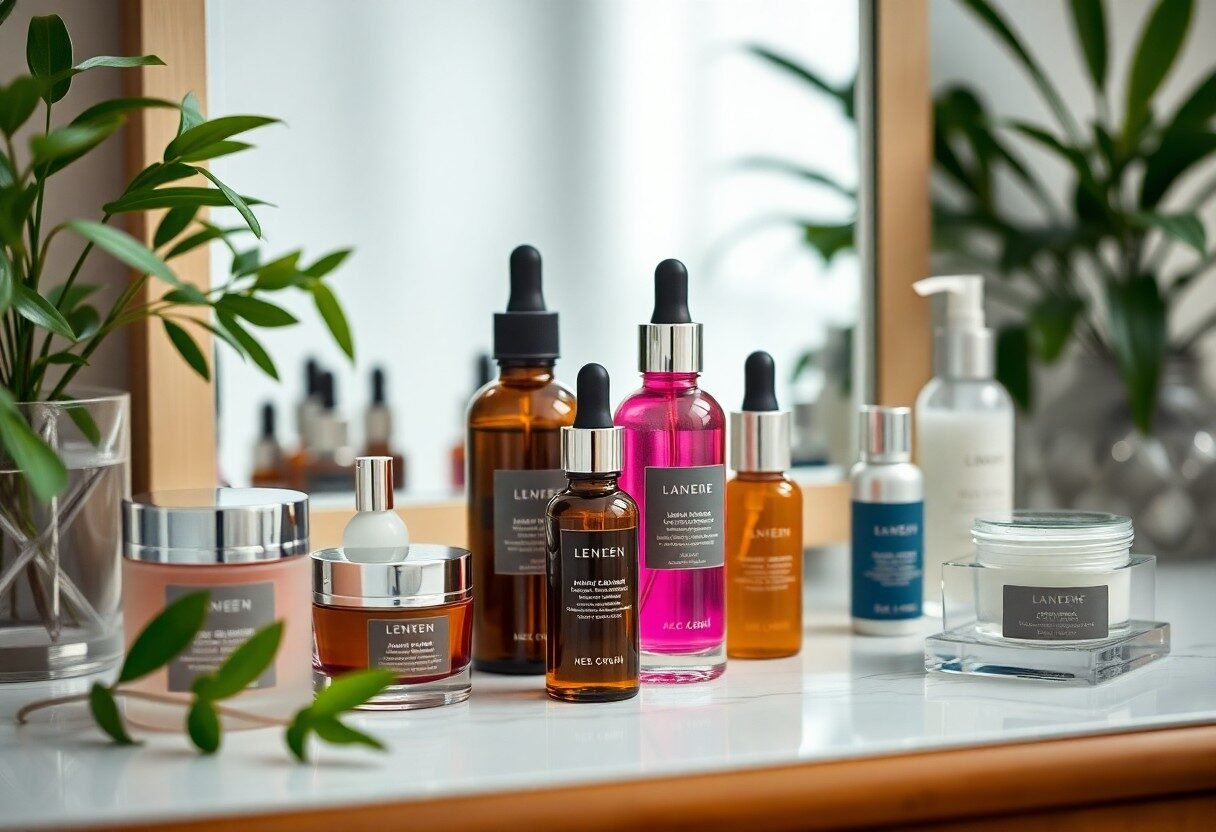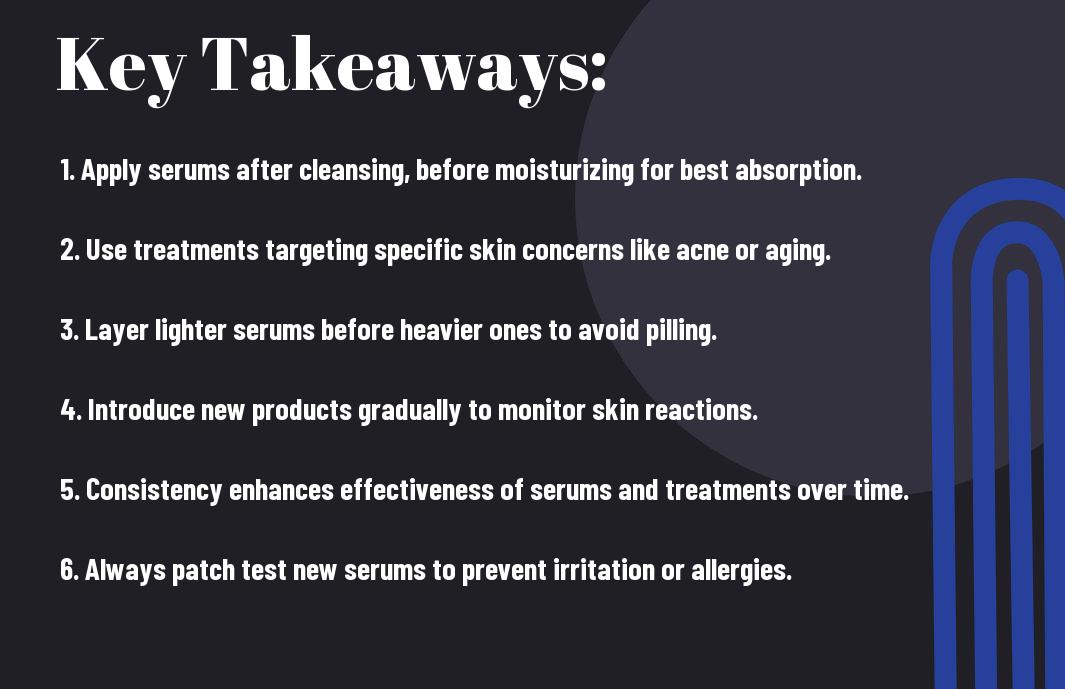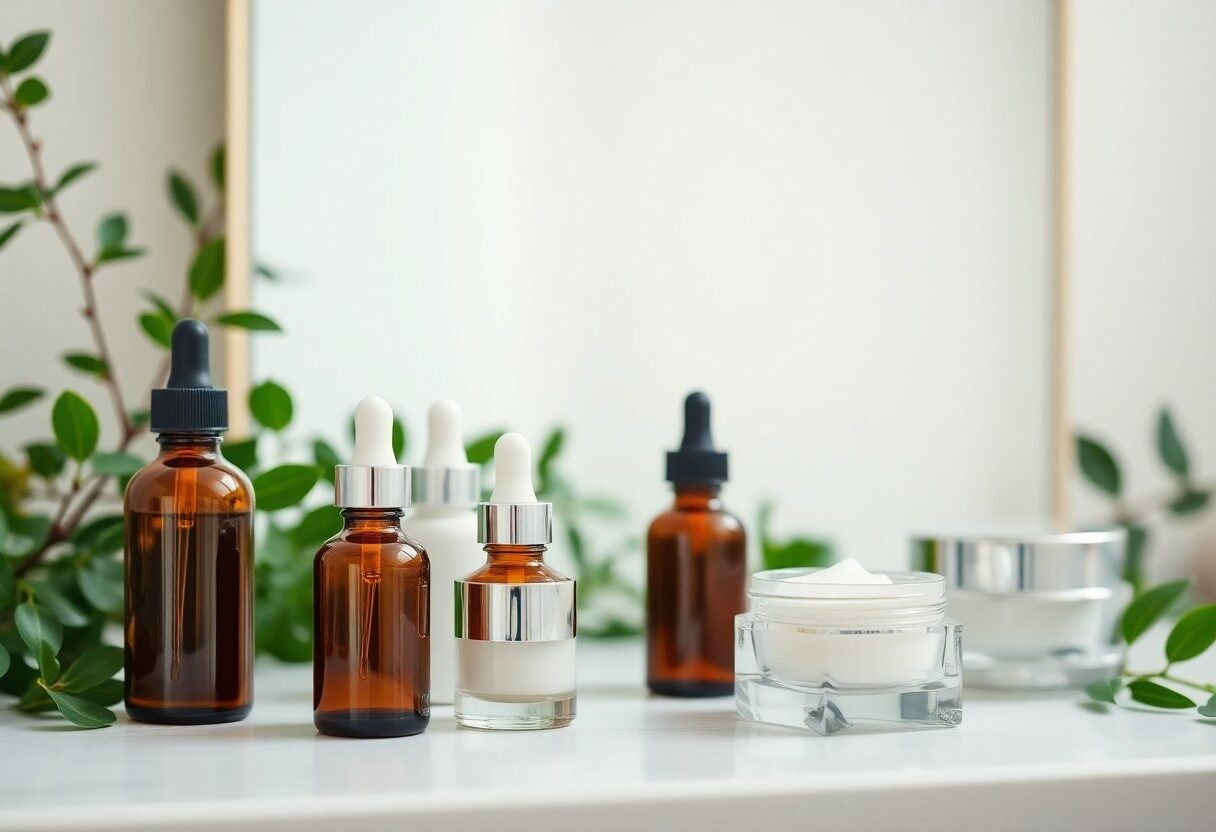
There’s a world of possibilities when it comes to enhancing your skincare routine with serums and treatments. As I explore various options, I realize how these powerful products can address specific skin concerns effectively. By incorporating targeted ingredients, like hyaluronic acid for hydration or retinol for anti-aging, you can transform your complexion. It’s vital to assess your unique skin type and needs, so I’ll guide you on how to layer products correctly and achieve optimal results without overwhelming your skin’s barrier.
Key Takeaways:
- Understand your skin type and concerns to select the most suitable serums and treatments.
- Layer products from thinnest to thickest consistency to ensure optimal absorption.
- Introduce new serums and treatments slowly to avoid overwhelming the skin.
- Pay attention to ingredient compatibility; some ingredients may not work well together.
- Consider the timing of application; some treatments are best used in the morning while others are more effective at night.
- Focus on consistency in your routine for the best long-term results; it may take time for visible improvements.
- Consult with a dermatologist for personalized recommendations and guidance tailored to your specific skincare needs.

Crafting Your Ideal Skincare Regimen
Building your skincare regimen begins with understanding the basics of what your skin truly needs. By selecting the right serums and treatments, you can tailor a routine that addresses your individual concerns while incorporating nourishing ingredients for optimal health.
Identifying Skin Type and Concerns
Before entering into product selection, recognizing your skin type is vital. Are you oily, dry, combination, or sensitive? Each skin type reacts differently to various ingredients, making it vital to identify if you’re struggling with specific issues like acne, aging, or hyperpigmentation. Conduct a simple at-home test, checking for dryness in your cheeks or excess shine on your forehead to pinpoint your unique needs.
Establishing Your Skincare Goals
Defining your skincare goals paves the way for an effective routine. Whether you’re targeting fine lines, improving texture, or enhancing radiance, having clear objectives helps narrow down the products you should be using. For instance, if hydration is your focus, incorporating serums with hyaluronic acid and glycerin can make a significant difference in your moisture levels and overall glow.
By setting specific goals, you can better track your progress and make informed decisions about changes in your regimen. For example, if you aim to reduce acne, you might include a salicylic acid serum in your routine, and monitor how your skin reacts over a few weeks. This tailored approach not only brings you one step closer to achieving your desired results but also fosters a sense of accomplishment as you visibly notice improvements in your skin.
The Science of Serums: Why They Matter
Serums play a pivotal role in skincare due to their concentrated formulas, which deliver powerful active ingredients directly to the skin. Unlike traditional moisturizers, their lightweight consistency allows for deeper penetration, effectively targeting specific skin concerns like fine lines, uneven skin tone, and hydration. Incorporating serums into your regimen not only enhances overall skin health but also allows for personalized treatments tailored to your unique skin needs.
Breakdown of Active Ingredients
Active ingredients in serums, such as vitamin C, hyaluronic acid, and retinol, serve distinct purposes. For instance, vitamin C is renowned for its brightening properties, while hyaluronic acid excels at moisture retention. Retinol, a form of vitamin A, promotes cell turnover and reduces the appearance of wrinkles. Understanding these components can empower you to select the right serum that aligns with your desired outcomes.
How Serums Target Specific Skin Issues
Serums target specific skin issues through varying mechanisms based on their active ingredients. For example, to address acne, you might choose a serum with salicylic acid to unclog pores, while those aiming for hydration would benefit from a formulation high in hyaluronic acid. By identifying your primary skin concerns, you can select serums that focus on those aspects, ensuring a more effective skincare routine. Additionally, formulations often combine multiple active ingredients to provide a multi-targeted approach, enhancing efficacy and results.
When I struggled with hyperpigmentation, incorporating a serum with niacinamide and vitamin C significantly advanced my skin’s clarity. Niacinamide improves skin barrier function and reduces redness, complementing vitamin C’s brightening effects. This synergistic relationship emphasizes how targeted ingredients work together to combat specific issues more effectively than using a single approach. By leveraging the power of well-chosen serums, you can pave the way for a healthier and more radiant complexion.
Integrating Treatments: Timing and Technique
Incorporating treatments into your skincare routine requires precise timing and technique to ensure optimal results. Applying treatments too early or late can lead to less effective results or even adverse reactions on your skin. I find that targeting specific skin issues, like blemishes or fine lines, requires not only the right product but also an understanding of when to use them in relation to your overall regimen. For instance, using a serum that boosts hydration before a treatment with active ingredients can enhance absorption and efficacy.
The Order of Application
Establishing a clear order of application is important for achieving the best results from your skincare products. I typically apply products from the lightest to heaviest consistency, starting with water-based products like essences and serums, followed by cream-based moisturizers. This ensures that each layer penetrates effectively without obstructing the absorption of subsequent products. For instance, if I’m using a vitamin C serum, I’d put that on first, allowing it to absorb fully before applying a heavier moisturizer.
Layering Products for Maximum Effectiveness
Layering products correctly can enhance their effectiveness, allowing your skin to reap the full benefits of each ingredient. I’ve found that waiting a few minutes between applying each product maximizes absorption, especially with potent actives like retinol or acids. Each layer builds on the previous one, creating a synergistic effect that can address multiple skin concerns. I recommend applying treatments with a gentle tapping motion, which can stimulate circulation and help distribute the product evenly.
For instance, after cleansing, I often start with a hydrating toner followed by a serum that targets specific concerns such as pigmentation or wrinkles. When using products with active ingredients, layering them appropriately allows each to perform its specific function without interference. An antioxidant serum, followed by a targeted treatment like a retinol, can drastically improve skin’s texture and tone. Just be mindful of how each product works with your skin type and adjust accordingly, as some combinations may be more suitable depending on individual skin responses.

Customizing Your Routine: Personalization Strategies
Personalizing your skincare regimen allows you to cater to your unique skin type and concerns. I always recommend starting with a thorough skin assessment, considering factors such as your age, environmental influences, lifestyle choices, and specific skin issues. This way, you can curate a routine that not only targets your goals but also maintains skin health and balance.
Adjusting Frequency Based on Skin Response
Monitoring your skin’s reaction to products is vital. If you’re incorporating a new serum or treatment, I suggest starting with a lower frequency—perhaps just a couple of times a week—to observe how your skin responds. Signs of irritation like redness or dryness indicate it might be best to scale back. Gradually increasing use allows you to find that sweet spot where your skin thrives.
Mixing and Matching for Optimal Results
Finding the right combinations of serums and treatments can elevate your skincare game. For instance, layering a hydrating serum with a targeted treatment can enhance efficacy without overwhelming your skin. Ingredients like hyaluronic acid can complement vitamin C, while niacinamide works harmoniously with retinol. The key is to identify ingredients that not only work together but also address multiple skin concerns simultaneously. It’s about creating a cocktail that hits all the right notes for your skin.
While mixing and matching, consider the potential interactions of different ingredients. For example, if you’re using a retinol treatment, pairing it with soothing agents like squalane can help mitigate sensitivity. Alternatively, avoid combining strong acids like AHAs or BHAs with retinol in the same routine to prevent irritation. By experimenting with layering and timing—like using a lighter product in the morning and richer moisturizers at night—you can find a regimen that optimally supports your skin’s needs, enhancing both the effectiveness of each product and the overall health of your complexion.
Navigating Common Pitfalls: What to Avoid
Building an effective skincare regimen can be tricky, especially with the myriad of products available. Often, well-meaning efforts to improve skin health can backfire. Being aware of common pitfalls helps ensure your routine remains beneficial rather than burdensome. Let’s explore two major missteps: overloading your skin with products and misunderstanding product interactions.
Overloading Your Skin with Products
Applying too many products at once can overwhelm your skin, leading to irritation and breakouts. I’ve been there—layering multiple serums, creams, and treatments in a single routine, thinking it would yield better results. Instead, I found my face was often red and reactive. Focusing on a few key products allows your skin the space to absorb and respond effectively, reducing confusion and promoting a healthier complexion.
Misunderstanding Product Interactions
Not all ingredients play well together; some can neutralize each other’s benefits or even cause irritation. For example, using products that contain both retinol and vitamin C in the same routine may lead to increased sensitivity. My own experience taught me the importance of spacing out these ingredients to avoid adverse reactions. Conducting thorough research or consulting with a dermatologist can help clarify appropriate pairings and timing, ensuring your regimen works harmoniously and delivers the results you desire.
Conclusion
On the whole, integrating serums and treatments into your skincare routine can significantly enhance your skin’s health and appearance. I encourage you to identify your specific skin concerns and choose products that align with those needs. By layering serums and treatments effectively, you can optimize their benefits and create a personalized regimen that works for you. Ultimately, consistency is key; small, daily efforts can lead to remarkable results over time. Invest the time in building a thoughtful routine, and your skin will thank you.
FAQ
Q: What is regimen building in skincare?
A: Regimen building refers to the process of creating a customized skincare routine that incorporates various products, including cleansers, moisturizers, serums, and treatments. The goal is to address individual skin concerns, improve skin health, and enhance overall appearance. A well-structured regimen can help enhance the effectiveness of each product used.
Q: How do I choose the right serums for my skin type?
A: Selecting the right serums involves understanding your skin type and its specific needs. For example, if you have oily skin, you might benefit from lightweight, oil-free serums with ingredients like salicylic acid. In contrast, dry skin may require hydrating serums containing hyaluronic acid or glycerin. Identifying your skin concerns, such as pigmentation or aging, will also guide your choices.
Q: How do I layer serums and treatments in my skincare routine?
A: The general rule of thumb for layering skincare products is to apply from thinnest to thickest consistency. Start with a cleanser, followed by a toner (if used), then apply serums first before any heavier treatments or moisturizers. Allow each product to absorb before applying the next. Typically, water-based serums go before oil-based products.
Q: Can I mix different active ingredients in my serums?
A: While some active ingredients can be combined, others may have conflicting properties. For instance, layering vitamin C and retinol can lead to irritation, so it’s best to use them at different times (morning for vitamin C and evening for retinol). Always do a patch test when mixing products and monitor your skin’s response before fully integrating new combinations into your routine.
Q: How often should I use treatments in my skincare routine?
A: The frequency of treatment products often depends on their formulation and the specific skin concerns being targeted. For example, exfoliating treatments might be used once or twice a week, while hydrators or serums addressing fine lines can be used daily. It’s important to follow the recommendations provided by the product or a dermatologist to avoid overuse.
Q: How do I adjust my regimen with changing seasons?
A: Seasonal changes can impact your skin’s needs. In winter, skin may require more hydration due to lower humidity, so consider incorporating thicker creams and hydrating serums. In summer, you might opt for lighter, oil-free products and add SPF. Monitor how your skin responds to different weather conditions and adjust your regimen accordingly to maintain optimal skin health.
Q: What should I do if my skin reacts negatively to a new product?
A: If you experience irritation, redness, or breakouts after introducing a new product, discontinue use immediately. Assess other products in your routine that may also be causing the issue. It’s helpful to introduce new products one at a time to identify potential irritants. Consult with a dermatologist if reactions persist, to explore alternative options that may be gentler on your skin.











